
MANUFACTURER'S SPECIFICATIONS:
Power Output: 180 watts, total IHF music power, 8-ohm load. RMS Power Output: 60 watts per channel, 8-ohm load, both channels driven. THD: Less than 0.15% @ rated output from 20 Hz to 20 kHz, with both channels driven. IM Distortion: Less than 0.15% @ rated output, with both channels driven. Total Noise (Mag. Phono): Less than 2µV equivalent input @ rated output into 8-ohm load. Frequency Response: +0, -0.5 dB, 20 Hz to 20 kHz at all levels up to rated output.
Damping Factor: Greater than 50 with 8-ohm load.
Input Sensitivity: (Low-Phono): 1 mV to equal 1 volt at preamp output.
Gain: (Low Phono to Recording Out): 40 dB.
Gain, Hi Level to Preamp Out: 20 dB.
Volume Tracking: Within 2 dB at all settings.
Maximum Power Consumption: 210 watts. ( Split primary windings permit conversion to 240-volt operation).
Dimensions: 15 3/8 in. W. x 5 3/4 in. H. x 14 in. D.
Price: $495.00.
When is an integrated amplifier really a professional preamplifier/control chassis plus a pair of powerful, basic amplifiers worthy of any superlatives we can conjure up? When it is the Marantz 30 Console Amplifier. This marvel of an amplifier has been around for nearly a year, now, but with all the backlog of receivers we've had to review, it's the first opportunity we've had to put 'it through its paces. And what a pleasure it was to operate and examine! Marantz has a knack of incorporating ample control facilities for the professional or semiprofessional user, without rendering the front panel too complex for the true audio connoisseur. Figure 1 shows the very intelligent and functional layout of this instrument. Major controls are located at the left and consist of four typically massive turned-metal knobs which complement the gold anodized heavy front panel. The selector includes settings for Tape Head, a pair of low-level Phono inputs, Tuner, and two Aux settings-no shortage of input facilities here! Volume and Balance controls are located in this area, as is a mode switch which provides settings for Mono ( Left + Right ), Stereo, and Stereo Reverse.
The center section of the panel contains slide-type tone controls, with separate levers for bass and treble for each channel. A fifth, matching lever in this area takes care of the tape-monitor functions. The Low Filter and High Filter knobs located in the right section of the panel each have three positions: 50 Hz, 100 Hz, and "out" for the low filter and 5 kHz, 9 kHz, and "out" for the high filter. The control labeled "Tone Control" is also a three-position switch which allows complete by-passing of the tone controls, and also has a position for automatic loudness compensation. The fourth knob in the area is a speaker selector control, with positions for main, remote, both or no speaker systems. Three jacks located at the extreme right edge of the panel are for dubbing in and out ( duplicating the tape in and out jacks on the rear panel, so that another tape recorder may be connected without having to go 'round the back-in custom installed set-ups), and the usual stereo headphone jack. Power is applied to the amplifier by means of a push-push button located at the lower right corner of the panel. Indication that power has been applied to the unit is by means of a soft glowing bead of light at center panel, just below the word "Marantz."
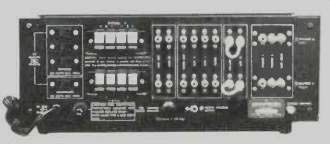
Fig. 2--Rear panel view.
The rear panel arrangement is shown in Fig. 2. Three switched convenience outlets and one unswitched outlet located at the left end of the panel enable connection of associated components. A line fuse is also located in this area. Next come the speaker connection terminals for two sets of stereo speakers. The terminals are the fool-proof "piano key" type. Depressing each key discloses a small hole just large enough to accept the stripped end of a speaker wire. Releasing the key clamps the wire solidly in place-no chance for speaker-terminal shorts here! Tape-out and Tape-in jacks come next, in parallel with those already mentioned in connection with the front panel layout.
A pair of 'scope output jacks follow, useful for connection to the horizontal and vertical inputs of an oscilloscope. Phase of input stereo signals, degree of separation, and balance are all easily checked by visual observation, using a scope, and Marantz provides the jacks for this purpose. High-level inputs are next ( Tuner, Aux 1, and Aux 2), followed by a pair of jumper cables which connect from "Pre amp Out" to "Amp In." It is this feature which renders the Marantz 30 usable as a separate preamplifier and basic amplifier combination for, aside from the common power supply, removal of these jumpers really enables the user to utilize the equipment as two completely separate units. With so many accessory items currently on the market (reverb units, multiple tone-contouring accessories, etc.) this is an added measure of flexibility that many users will appreciate. Low-level inputs (Phono 1, Phono 2, and Tape Head ) are located at the right end of the panel, as is a rugged chassis-ground terminal.
Along the lower edge of the panel, there is a center-channel output jack with an associated center-channel level control.
No simple "voltage output" this, but a resistively matrixed "A+B" output that can be used to drive a third, center loudspeaker system, if desired, using an additional power amplifier externally.
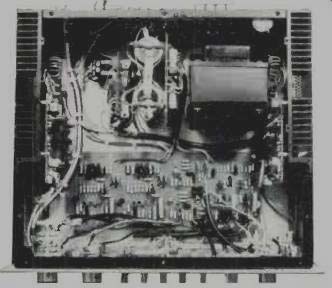
Fig. 3--Internal view.
Removing the walnut enclosure and top protective metal plate, we see that the Marantz 30 chassis is laid out in the form of an enclosed "U" shape, with massive heat sinks at each end of the structure used to dissipate output transistor heat and to support the entire structure. The heat sinks are fully twice as large as those we have seen used on amplifiers having equal power ratings. That, and conservative design, account for the fact that at no time during our measurements (including extended "full power" tests) were the heat sinks more than mildly warm to the touch. The "innards" can be seen in Fig. 3 which, though reduced in size, should still give the reader an idea of the rugged components (massive transformer and electrolytics) used in the more-than-ample power-supply design.
The circuit is divided into logical modular sections, all securely fastened and inter-wired by carefully routed harness-type wiring.
The extreme flexibility of the circuit layout and switching facilities of the Marantz 30 can best be understood by examining the overall block diagram of Fig. 4. Note that the preamplifier and power amplifiers are shown as separate diagrams since, in every sense, they really are separate units joined only by jumper cables supplied. The speaker overload protection circuits provide a minimum 5 second delay after turn-on to protect the speakers from any turn-on surges. This circuit also provides instantaneous turnoff for high-amplitude low-frequency (below 10 Hz) surges in the audio output, with a minimum 5-second turn-on delay upon resumption of normal operation.
The speaker overload protection circuit is, in reality, a separate circuit board. Output lines from each power-amplifier channel feed through this module to a rugged, 24-volt relay whose coil is activated by a three-transistor circuit powered by a separate bridge-rectifier arrangement. Normally open contacts of the relay are closed after a time delay of approximately five seconds after "turn-on," connecting the audio output lines to the speaker switch, headphone, and center-channel circuits. As noted earlier, a sudden surge of high-amplitude low-frequency current (such as might occur because of the transients associated with plugging in or pulling out an input plug while the unit is in operation) will instantaneously open the relay contacts, protecting speakers and/or headphones from possible damage. Normal operation is restored after an additional waiting period of approximately 5 seconds.
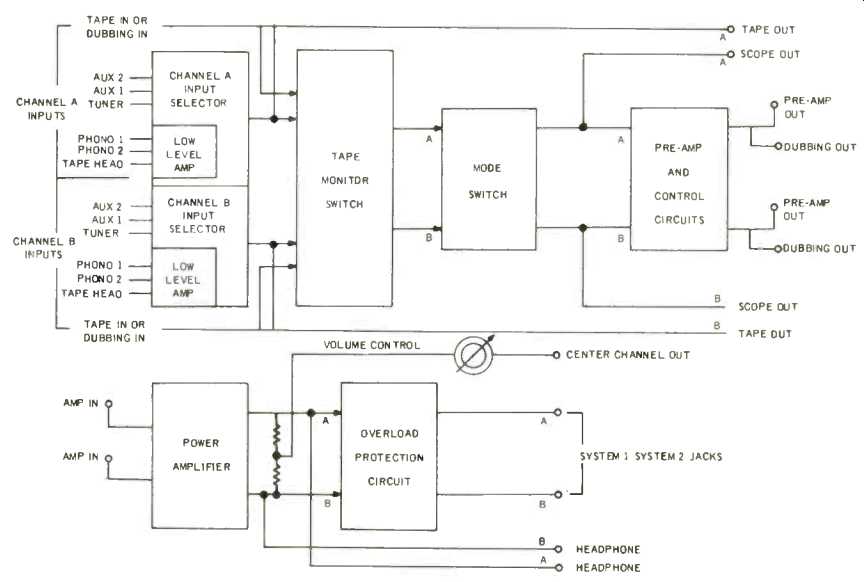
Fig. 4--Simplified block diagram of Marantz 30.
Test Measurement
Measurement of the Marantz 30 performance specifications proved to be somewhat of a frustrating experience. In the case of our THD measurements, for example, we know that our audio oscillator, read directly by our distortion analyzer, puts out 0.05 percent distortion.
Thus, until we read more than that figure, when measuring a product, we must assume that we are reading input signal distortion and that the product distortion is necessarily lower than 0.05 percent.
We did not begin to creep above this "equipment limited" reading until each channel of the Marantz 30 was putting out just over 50 watts! Furthermore, we read 0.1 per cent THD at a power output of 60 watts per channel ( with both channels driven) instead of the 0.15 per cent claimed by Marantz. In fact, at 66 watts output per channel, the THD reading was only 0.3 per cent. These values are plotted in Fig. 8, along with the IM distortion curve which is seen to conform nicely to published specs (limited, again, by our test equipment which is good down to about 0.07 per cent IM) . Power bandwidth, shown in Fig. 6, extends from about 10 Hz to well beyond 40 kHz, but more importantly, full power output is obtainable at all audible frequencies at less than rated distortion (which, in this instance, is a miniscule 0.15 percent). Yes, we mean 60 clean watts at 20 Hz (or 20 kHz, if you like) with less than 0.15 percent THD. It is this kind of specification that separates the outstanding from the very good.
Tone-control and high and low filter response characteristics are shown plotted in Fig. 7. Since the front panel calibration of the tone levers is given in 2-dB steps, we measured response at each and every setting of these levers. Note that the individual curves shown are almost exactly 2 dB apart at around 80 Hz (in the case of bass) and 10 kHz (in the case of treble). Although a double network is used in the filter circuits, we would have liked to see a bit steeper attenuation from these filters.
We found that frequency response with the tone controls set flat was within a fraction of a dB of the "straight line" curve that we measured when the tone controls were switched out of the circuit altogether. This speaks very well for this tone control design. Intrigued with the precision response, we decided to use the "scope output" facility--not to check stereo separation of our source material (which was a single audio generator, up to now), but to check the phase characteristics of the two stereo channels of the Marantz 30. Thus, we fed a common signal to channels A and B and observed the phase relationship on our scope at every audio frequency. The results shown in Fig. 8 are what we obtained with tone controls out of the circuit at frequencies shown. The scope photo in Fig. 9 (hardly distinguishable from that in Fig. 8) is the result obtained with the tone controls "in-circuit" but set to the flat position. Only the tightest of component tolerances could lead to such total uniformity of outputs from two separate channels under such conditions! We normally observe square-wave response at 100 Hz and 10 kHz in our amplifier reports. In the case of the Marantz 30, to have done so would have resulted in our presenting two practically identical squared-off photographs. Please bear in mind, then, that departing from normal procedure, we photographed square-wave response at 40 Hz and 20 kHz instead, and the results shown in Fig. 10 are as good or better than most amplifiers subjected to the 100 Hz and 10 kHz square wave test.
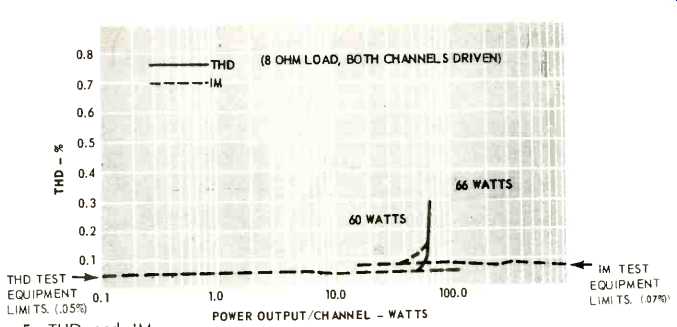
Fig. 5--THD and IM distortion.

Fig. 6--Power band width.
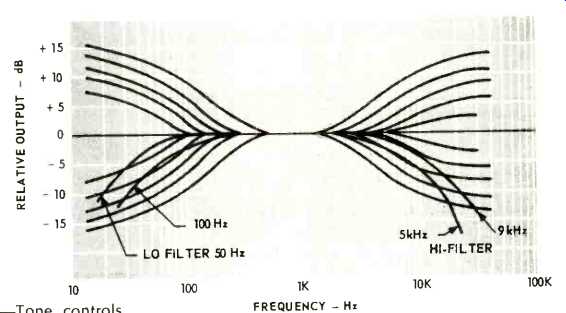
Fig. 7--Tone controls and filter.
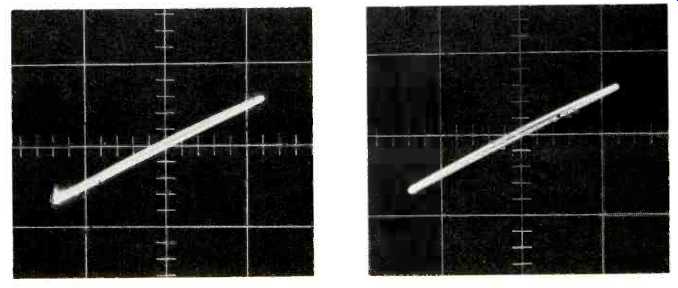
Fig. 8 (left)--Almost-identical phase responses using outputs from both channels.
Tone controls bypassed. Test frequency: 10 kHz.

Fig. 9 (right)--Introducing tone controls shows virtually no change in phase
relationships.
Fig. 10--Square-wave responses at 40 Hz (upper) and 20 kHz (lower).
Listening Tests
There are few superlatives that can adequately describe the flawless listen ability of the Marantz 30. "Effortless" ability to reproduce source material of extreme dynamic range and transient effects does not begin to tell the whole story. We hooked up this unit to no less than three different pairs of speaker systems, ranging from medium-priced, low efficiency bookshelf types to fairly efficient floor-standing larger systems. The only differences noted were in the coloration contributed by the speakers themselves. The amplifier was always in the background (as it should be) contributing no audible noise, hum, or distortion at any level of power. The variable crossover design of the tone control circuits showed up to particular advantage in our experiments in that our listening room requires just a bit of bass attenuation at about 100 Hz and a small amount of treble boost starting at around 5 kHz because of our particular "upholstery." Both of these minor corrections were attained easily without affecting multiple octaves of response. All controls are smooth in use, and a direct A/B test with tone controls set flat and switched in and out of the circuit produced absolutely no audible difference, as would be expected from the electrical measurements.
With all its control features and flexibility, the Marantz 30 is sure to find its way into professional sound studios, recording studios, and other applications where precise sound monitoring is essential. At its attractive price of $495.00, this two-for-one component is, at the same time, well within the reach of the serious music listener who wants that extra, if subtle, measure of perfection.
-L.F.
(Audio magazine, Aug. 1970)
Also see:
Marantz Model 250 Stereo Power Amplifier (Jun. 1972)
Marantz Model 250 Stereo Power Amplifier (ad, Aug. 1972)
Marantz Model 2500 Stereo FM/AM Receiver (Equip. Profile, Feb. 1978)
Marantz Model 22 AM/FM Receiver (Apr. 1970)
Marantz Model 1150D Stereo Control Amplifier (Mar. 1976)
Marantz PM-94 Integrated Amplifier (Dec. 1988)
Marantz Model 50308 Stereo Cassette Deck (Dec. 1978)
= = = =